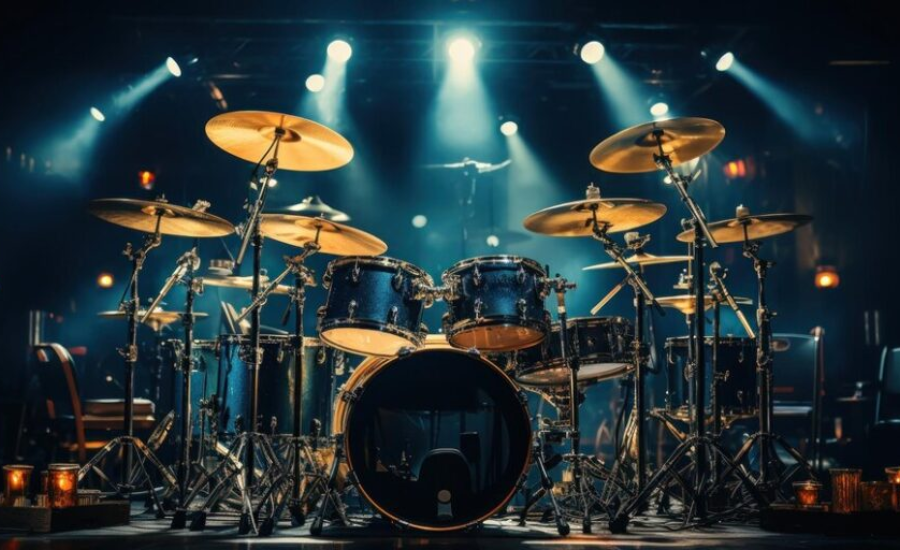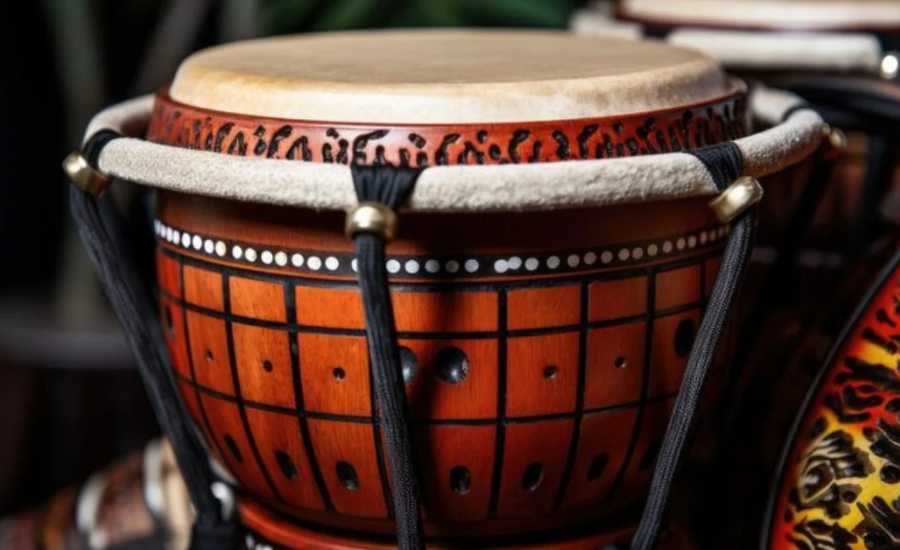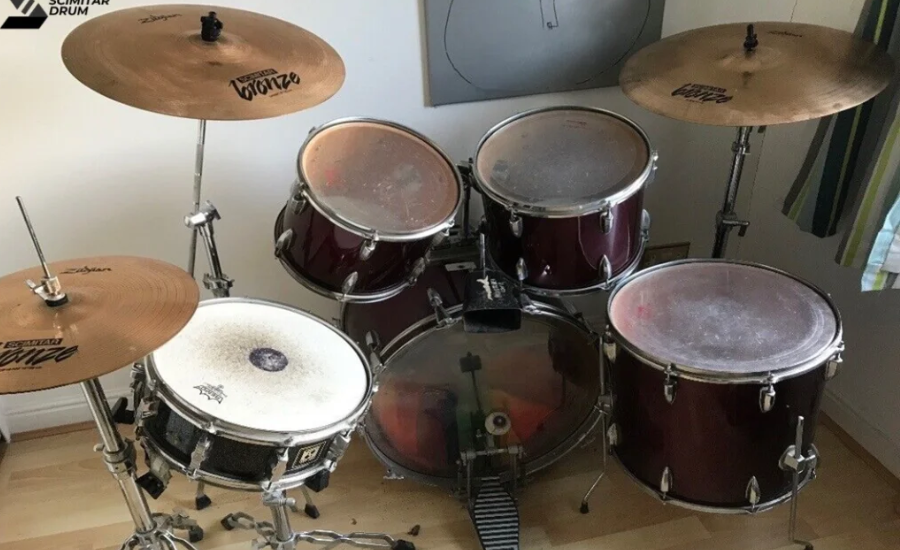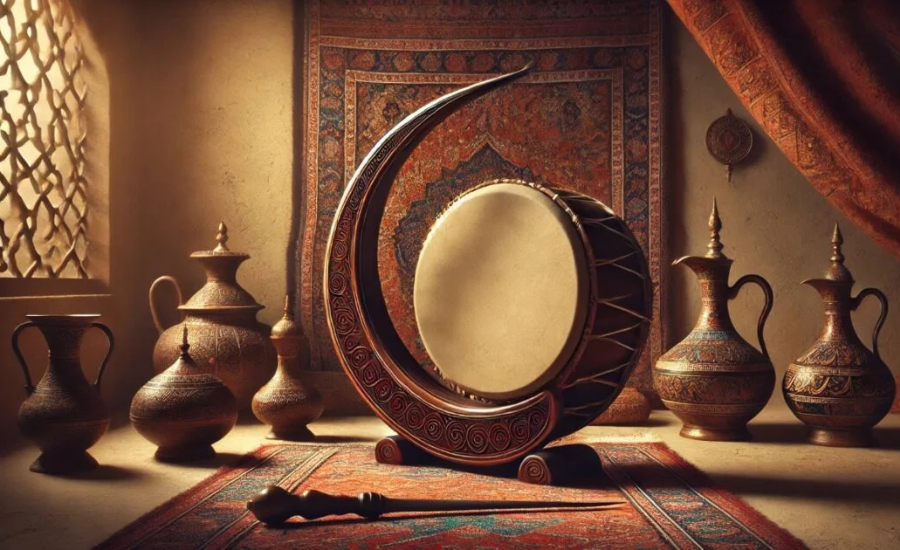The Scimitar drum is a fascinating percussion instrument that stands out with its crescent-shaped design. To play it, you use a stick to hit the drum’s surface, which is covered with animal hide. This traditional drum isn’t just about making music; it carries a wealth of cultural meaning and significance.
Crafted from a mix of animal hide, wood, and metal, the Scimitar drum represents more than just a musical device. It is deeply embedded in the spiritual and cultural practices of the communities that use it. Each material used in its construction contributes to its unique sound and symbolic value. The drum embodies traditional customs and beliefs, connecting its players to their heritage and the spirit of their ancestors.
What Is Scimitar Drum Meaning?

The Scimitar drum carries a rich and profound meaning. Its name, inspired by the curved shape of a scimitar sword, reflects its distinctive design. The drum features a curvy stick or rod, often resembling a sword, which is used to strike the drumhead and produce vibrations.
The sounds produced by the Scimitar drum are diverse and dynamic, varying with each beat. This variety in sound adds to its unique character and significance. Beyond its musical role, the drum holds cultural and spiritual value, symbolizing the traditions and beliefs of the communities that use it. Its design and the range of sounds it produces make it a powerful tool for expressing heritage and connecting with deeper meanings.
Historical Background Of Scimitar Drum
The scimitar drum boasts a rich historical background that stretches back to ancient civilizations. The diverse cultures of the Middle East, North Africa, and South Asia trace the drum’s origins. Over the centuries, regional influences have shaped its design and construction methods, evolving the drum accordingly.
Initially, the drum’s form and playing techniques were influenced by the cultural practices of these regions. As time passed, the drum adapted to different environments, incorporating new materials and construction methods. This evolution reflects a blend of traditions and innovations, resulting in the scimitar drum’s unique character and significance in the musical heritage of these cultures.
Cultural And Symbolic Meanings Of Scimitar Drum

Symbolism Across Cultures
The scimitar drum holds deep symbolic meanings in various cultural contexts. In some traditions, it is a symbol of strength and bravery, reflecting the powerful impact of its deep, resonant sounds. In other cultures, it represents cultural heritage and identity, serving as a link to ancestral traditions and customs. The drum’s design, which resembles the curved scimitar sword, further enhances its symbolic significance, embodying qualities of valor and historical continuity.
Role in Ceremonies and Rituals
The scimitar drum plays a significant role in various ceremonies and rituals, where it is used to invoke spiritual connections or mark important events. Its presence in these ceremonial contexts underscores its importance beyond just being a musical instrument. The drum’s sound and the ritualistic use of its beats help to create a sacred atmosphere, reinforcing its role in spiritual and cultural practices.
Playing The Scimitar Drum: Techniques And Sounds
The scimitar drum offers a range of playing techniques, each creating a different sound. The most common method is striking the drumhead with the palm, which produces a deep, resonant tone. Using the fingers to tap the drumhead yields a higher-pitched sound while striking it with a stick generates a sharp, percussive effect.
The drum is distinguished by its unique sound quality, characterized by a deep resonance due to its large drumhead and heavy frame. It can be played with varying dynamics, from soft, subtle notes to loud, powerful beats, allowing for a wide range of expressive possibilities.
Comparison Of The Scimitar Drum To Other Drums

| Drum Type | Tone Characteristics | Comparison Highlights |
|---|---|---|
| Scimitar Drum | Deep, resonant sound with rich tonal quality | A Unique blend of depth and resonance |
| Bodhran | Muted, shallow tone | Less resonant compared to the scimitar drum |
| Djembe | Bright, vibrant tones | More vibrant but lacks the depth of the scimitar drum |
The scimitar drum, bodhran, and djembe are all prominent frame drums, but they each offer distinct auditory experiences. The scimitar drum stands out with its deep, resonant tone, providing a rich and profound sound that sets it apart from the bodhran and djembe. In contrast, the bodhran produces a more muted and shallow tone, while the djembe is known for its bright and vibrant sounds. The scimitar drum combines elements of both depth and resonance, giving it a unique place among these traditional percussion instruments.
The Scimitar On Screen: Film And Television Appearances
Classic Adventures and Mysteries
- “The Arabian Nights” (1942): This film portrays the scimitar as a symbol of danger and adventure, with the protagonist Ali Baba using it to protect his treasures and navigate perilous situations.
- “The Thief of Baghdad” (1940): In this fantasy tale, the scimitar is a key weapon for the titular thief, adding an element of mystery and intrigue to the magical narrative.
Historical And Symbolic Representations
- “Lawrence of Arabia” (1962): The scimitar in this historical epic represents the Arab rebellion against the Ottoman Empire, symbolizing the strength and resilience of the Arab people.
Supernatural and Fantasy Elements
- “The Mummy” (1999): The scimitar, wielded by the mummy, enhances the film’s supernatural aura and the menacing presence of the ancient creature.
- “The Lord of the Rings: The Fellowship of the Ring” (2001): In this fantasy adventure, the scimitar used by Faramir contributes to the film’s sense of wonder and epic journey.
In these diverse portrayals, the scimitar is more than just a weapon; it serves as a powerful symbol that deepens the storytelling and enriches the cinematic experience.
Notable Performers And Recordings
Influential Performers
Several remarkable musicians have brought the scimitar drum to life, significantly contributing to its popularity and recognition. Among the most influential scimitar drummers is Omar Faruk Tekbilek. Hailing from Turkey, Tekbilek is renowned for his masterful technique and inventive approach to the instrument. His albums, such as “The Prayer” (1990) and “The Light” (1995), highlight his unique style and the versatility of the scimitar drum.
Recommended Recordings
To truly appreciate the enchanting sound of the scimitar drum, you might enjoy the following recordings:
- “The Prayer” by Omar Faruk Tekbilek
- “The Light” by Omar Faruk Tekbilek
- “Sufi Meditation” by Zikr Ensemble
- “Dervish Dance” by Nusrat Fateh Ali Khan
- “The Ecstasy of Rumi” by Mercan Dede
These recordings offer a glimpse into the rich and diverse sounds of the scimitar drum, showcasing its ability to evoke deep emotional and spiritual responses.
The Scimitar In Video Games
Video games have embraced the scimitar, integrating its distinctive design and historical significance into engaging and powerful weaponry.
Iconic Scimitars in Gaming
- “The Legend of Zelda: The Wind Waker” (2002): In this popular game, the protagonist Link wields a scimitar known as the “Wind Waker.” The weapon’s design and mechanics draw inspiration from traditional scimitars, making it a favorite among players for its blend of style and function.
- “Assassin’s Creed” (2007): The Assassin’s Creed series features various scimitars used by its skilled assassin protagonists. The designers craft these scimitars to be both lethal and visually striking, which enhances the characters’ stealth and combat abilities.
- “God of War” (2018): Kratos, the game’s main character, utilizes several weapons, including a scimitar-like weapon called the “Blades of Chaos.” The game’s intense and powerful combat experience benefits from the design and mechanics of this weapon, which draws inspiration from traditional scimitars.
In these games, the scimitar is more than just a weapon; it serves as a key element in gameplay and character development, reflecting its enduring appeal and versatility.
The Future Of The Scimitar Drum: Embracing Tradition And Innovation

Looking ahead, the Scimitar Drum will continue to blend tradition with modernity. As technology and global influences increasingly shape music, the Scimitar Drum highlights the need to preserve cultural heritage while embracing new ideas and innovations.
Its lasting appeal stems from its ability to adapt to contemporary changes while staying true to its unique heritage. As musicians and craftsmen continue to experiment with new materials, techniques, and sounds, the Scimitar Drum is likely to evolve in exciting ways. Despite these advancements, its deep connection to historical traditions will always be a core aspect of its identity, ensuring that the Scimitar Drum remains a beloved and respected instrument for future generations.
All In All
The scimitar drum is a crescent-shaped percussion instrument known for its distinctive sound and cultural significance. Played with a curved stick or rod, this traditional drum produces a range of tones depending on the technique used. Striking the drumhead with the palm creates a deep, resonant sound while using the fingers or a stick yields higher-pitched or sharper, percussive notes. Its unique sound quality features a deep resonance and a wide range of dynamics, setting it apart from other large-frame drums like the bodhran and djembe.
Historically, the scimitar drum has roots in ancient civilizations, influenced by cultures from the Middle East, North Africa, and South Asia. Over time, its design and construction have evolved, incorporating various materials and techniques. The drum carries symbolic meanings in different cultures, representing strength, bravery, and cultural heritage. In ceremonial and ritual contexts, it plays a significant role in invoking spiritual connections and marking important events. As technology and globalization shape modern music, the scimitar drum continues to balance tradition with innovation, preserving its historical essence while embracing new developments in its craft.
FAQs About the Scimitar Drum
What is the scimitar drum?
The scimitar drum is a crescent-shaped percussion instrument with a distinctive design that includes a curved stick or rod used to strike the drumhead. This traditional drum produces a deep, resonant sound and rich tonal quality through various playing techniques, such as striking with the palm, fingers, or a stick.
What are the key characteristics of the scimitar drum’s sound?
The large size of its drumhead and its thick, heavy frame enhance the scimitar drum’s deep, resonant tone. It can produce a wide range of dynamics, allowing for both soft and loud play. This makes it distinct from other large frame drums like the bodhran, which has a more muted tone, and the djembe, known for its bright, vibrant sounds.
How does the scimitar drum compare to other drums?
The scimitar drum is similar to other large frame drums, such as the bodhran and djembe, but it has its unique sound. Compared to the bodhran’s muted and shallow tone, the scimitar drum offers a deeper and more resonant sound. When compared to the djembe’s bright and vibrant tones, the scimitar drum provides a richer, more resonant quality, making it distinctive among percussion instruments.
Who are some notable performers associated with the scimitar drum?
Omar Faruk Tekbilek is one of the most influential scimitar drummers, known for his virtuosic playing and innovative use of the instrument. His albums, such as “The Prayer” and “The Light,” showcase his unique style and the versatility of the scimitar drum.
Stay tuned for more updates and alerts visit: The News!

